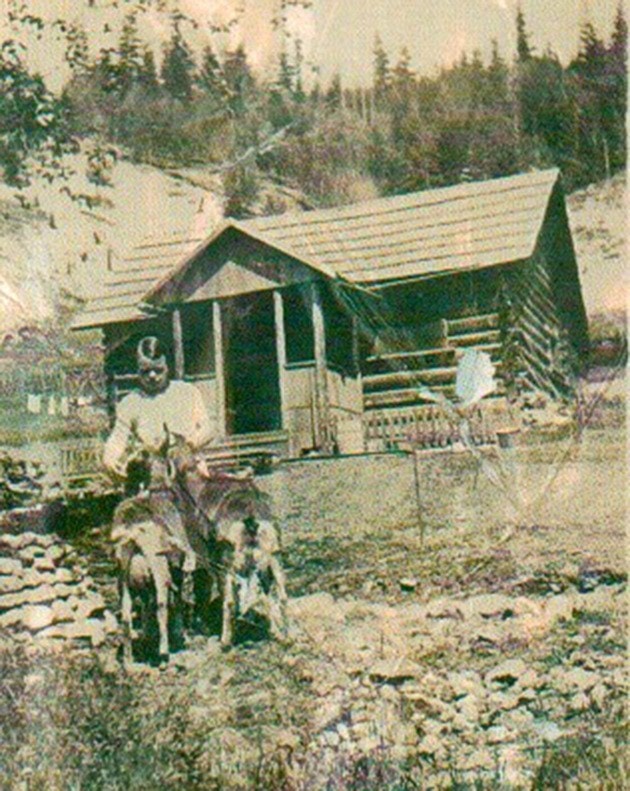Eleanor Deckert
There's a "Sweet Spot" every spring, after the snow is gone but before the leaves open. No summer hordes of mosquitoes. No autumn hunters. No pre-winter snow at higher elevations. The green veil of every bush is not yet hiding contours of the land or other clues from the curious explorer.
Now is a great time to pack-up a picnic. Bring your camera, binoculars and outdoors pack (fire starter, rain gear, first aid and other emergency preparedness items) and head out to explore an old homestead.
Safety first! Beware of dips in the landscape which might be the lid of a collapsed well, root cellar or out-house hole. Rusty cans and broken glass might be in a garbage dump near by. Fallen fences of hazardous barbed wire can be hidden in the overgrown grass. Floors and beams are rotten. Nails and spikes are everywhere. Resist the temptation to step inside. Stay outside of old buildings and look in with observant eyes.
Whenever I approach an old homestead, I experience a heightening of my senses. Eyes and ears are  wide open seeking impressions. Also eager are my sense of adventure, sense of family, sense of time, sense of imagination. If I can imagine the people who lived here, I can see all around me what they did and why they did it.
wide open seeking impressions. Also eager are my sense of adventure, sense of family, sense of time, sense of imagination. If I can imagine the people who lived here, I can see all around me what they did and why they did it.
When I come to a cabin, I look at the structure, methods and materials used for construction, home made details, store bought hardware, glass, interior finishing materials or furnishings.
I notice the view from the door and windows and also the relationship of the door and windows to the sun's light. No matter how broken, collapsed or decayed, there are parts of this former home which are still the same now as they were when people lived here: the lay of the land, the location of water, the east-west, north-south orientation of the slopes and buildings.
Where young saplings grow now, open spaces were then. Was it a garden? Road? Work space? Where did they get water? How far is it to the rail road? Are there fences which might have enclosed animals? Are there signs of an out-house, well, root cellar, grave, barn, other buildings? Are there clues indicating what they were used for?
I like to slow down and notice little things that are specifically designed or invented for this place, this house, this family. A hook to hold the heavy root cellar door open. A porch at just the right angle to view the scenic valley. The shelf near the stove so the cook will have utensils handy. Pathways lead to essentials such as the now-fallen out house, daily barn chores, all-important water source, nearby wood shed.
Once I came to a grassy slope where a dairy barn still had the names of each cow over each stall: Daisy, Belle, Clover. A swiftly flowing frigid creek ran through a spring house so the milk cans would quickly chill. The barn was located near enough to the house for the people to hear any disturbance. The grassy pasture hill was also visible from the house. No invading predator would be unseen.
Where the valley floor meets the mountain slope one cabin's windows were protected by saw blades along the bottom of each window sill. It is easy to guess that frequent visits from bears, hungry each spring and strong enough to force entry, motivated this ingenious use of a tool usually used for another purpose. Layers of newspapers lined the walls as insulation and were stuffed in between the logs as chinking. What year are the newspapers? What city did they come from? What was news at that time?
One of my favourite discoveries was when I stood in the door way of an abandoned cabin, wondering what it was like to be the woman who had lived here. She would have had so many necessary chores to do daily, seasonally, annually. Just like her, I can enjoy the slant of the sun and hear the river rushing down below. I felt how valuable every bucket of water would be that she had carried up the steep sloping path. But then I saw how the deliberate planting of lilac bushes on either side of the path brought pleasure to this lady who had the bare essentials and the luxury of beauty so closely linked.
In another location several buildings with many artifacts left behind made for an adventure of observation and an attempt to understand the family who lived there. One shed had skinning boards, hooks and nails for hanging things along the highest logs. Surely is was a work place for a trapper to prepare the many skins collected through the winter months. The hay barn also had discarded boots, boxes of belongings, papers and tools. Looking through the papers I could see the prices of purchases, colour photos in magazines and headlines in newspapers. In the house, besides interesting dishes, cans and boxes from food items, I was especially interested in a child's school scribbler. Drawings and printing, math problems and spelling lists were not so different from any child of the same age no matter what decade.
Mindful of both private property and any explorers who follow, I deliberately leave things as they are. An old saying is a good guide. "Take only pictures. Leave only foot prints."
Below: The Kessler homestead is now mostly collapsed.

